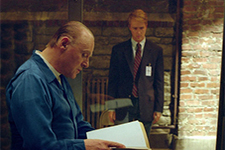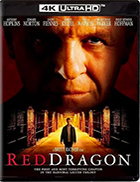Red Dragon (4K UHD)
|  After the self-conscious irony and black comedy of Ridley Scott’s Hannibal (2001), it was a relief to see director Brett Ratner take Red Dragon, which takes place prior to the events in the multiple-Oscar-winning The Silence of the Lambs (1991), back to a darker place. If Hannibal was about anything, it was about how the character of Dr. Hannibal Lecter had seeped so deeply into our cultural conscience that it was easier to deal with him as a caricature, rather than a character. What was brave about Red Dragon was that it reasserted Lecter’s potency as a screen villain. The audience response to Anthony Hopkins’ third go-round as Lecter was interesting because, despite Ratner’s and Hopkins’ stated intentions otherwise, they seemed to want to view Lecter as camp. Granted, many of his lines of dialogue were meant to have a darkly comedic ring to them, but the way in which viewers responded to them were wholly different from the response garnered in 1991, when Lecter was a genuine revelation—a sinister character whose evil and charming personality were so fundamentally intertwined that it was impossible to tell where one ended and the other began. That is a chilling concept in its own right, and Hopkins, with his refined persona and fiercely intelligent, deep-set eyes, made the most of it. But, a decade later, even when he was at his most sinister, audiences wanted to laugh, but the resulting chuckles were more uneasy than anything—laughter as a defense, not a response. Despite Lecter’s strong presence in the film, much like The Silence of the Lambs, Red Dragon is not his story. Rather, it is the story of Will Graham (Edward Norton), a brilliant young FBI agent who almost dies at Lecter’s hands in the film’s opening sequence. Graham ends up capturing Lecter, thus he is the one responsible for putting him in the dank bowels of the Baltimore psychiatric hospital where we first met him on-screen. The event was so traumatic for Graham—physically and mentally—that he retired from the bureau to lead a quiet, secluded life in the Florida Keys with his wife, Molly (Mary-Louise Parker), and their young son. Graham is brought back when FBI director Jack Crawford (Harvey Keitel) convinces him to help the bureau catch another serial killer, this one known as “The Tooth Fairy” (Ralph Fiennes), although his real name is Francis Dolarhyde. Graham has a special gift of creative imagination, which allows him to think like a killer; thus, he sees things in the evidence that others don’t, which makes him invaluable. However, Graham has his limitations, and he ends up turning to Dr. Lecter for help. If this sounds familiar, that is because it is roughly the same narrative as The Silence of the Lambs except that a traumatized male FBI agent is in the place of a burgeoning rookie female agent. Similarly, we know who the Tooth Fairy is from very early on, and we follow parallel stories—the serial killer’s and the FBI’s—with Dr. Lecter straddling the two. Unlike Silence’s Buffalo Bill, Dolarhyde is a more sympathetic villain. His murders are particularly gruesome—he breaks into family’s homes, ritualistically slaughters everyone, and then puts pieces of broken mirror in their eyes—but he is presented as a sad abuse case, a particularly warped cog in the cycle of familial violence. There is an intriguing subplot in which he becomes involved with a blind woman named Reba McClane (Emily Watson), who, despite her heightened senses, is unable to detect that she is dating a psychopath. However, their relationship goes a long way toward further humanizing Dolarhyde, showing that he still has the capacity for human tenderness. This was the second time Red Dragon had been adapted to the screen, the first being Michael Mann’s Manhunter (1986), which seems to have had little influence on the new version even though the same cinematographer (Dante Spinotti) shot both films. Screenwriter Ted Tally, who won an Oscar for adapting The Silence of the Lambs, sticks closer to Thomas Harris’ original novel, and director Brett Ratner does his best to mimic the style of Silence director Jonathan Demme. Ratner, who at that point had only directed four other films, three of which were action-comedies starring Chris Tucker (Money Talks and the first two Rush Hour movies), seemed an unlikely choice to helm the film, but so did Demme back in 1991, when his most significant credits were off-beat comedies like Something Wild (1986) and Married to the Mob (1988). Ratner makes similar use of the close-up, emphasizing the deeper connections between Graham and Lecter. He also self-consciously gives us a virtually shot-for-shot replication of the sequence in which Clarice Starling was first led down to Lecter’s cell. In this case, of course, it is Graham making the trek, and the tension is entirely different because he’s not meeting Lecter for the first time, as Clarice was, but rather facing the man who almost killed him for the first time since their last deadly encounter. Graham is more in control of his relationship with Lecter, but there is an inner fear that Lecter senses. This, however, is the point in which Manhunter is the superior film, as Ratner does not do as good of a job conveying Graham’s inner turmoil. On the whole, though, Red Dragon is a worthy (if arguably unnecessary) follow-up to The Silence of the Lambs. If it ultimately pales in comparison, that has less to do with Red Dragon’s weaknesses than with Silence’s virtuosity. It was certainly a step above Hannibal, if only because the story is so much more intriguing. Even though we know who the killer is, the narrative is tightly wound around a “beat the clock” scenario in which the FBI must track the Tooth Fairy down before he strikes again, and the key to doing that is figuring out how he operates. That Lecter is such an integral part of the process shows the underlying brilliance of Thomas Harris’ original conceit: It takes a killer to catch one. The films made from his novels are filled with extreme characters—in Red Dragon, Dolarhyde has tattooed the back of an enormous dragon from a William Blake painting on his own back and is convinced that he metamorphoses into the titular creature when he kills—but what makes them so chillingly effective is the way in which he shows that there is a fine line between the heroes and the villains, which is why Dr. Hannibal Lecter will remain in our cultural conscious for a long, long time to come.
Copyright © 2023 James Kendrick Thoughts? E-mail James Kendrick All images copyright © Kino Lorber | |||||||||||||||||||||||||||||
Overall Rating: 

 (3)
(3)


